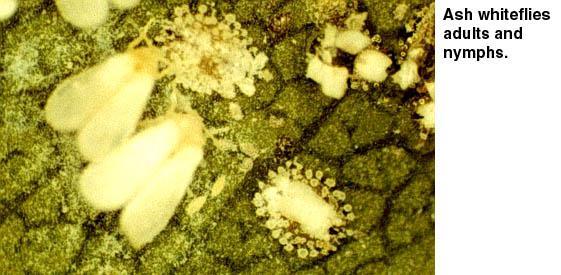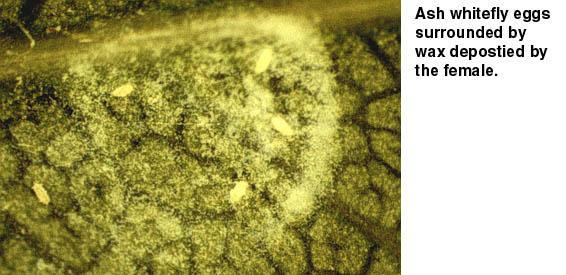General Information
The ash whitefly, Siphoninus phillyreae, is a tiny insect that attacks a variety of crop and ornamental trees. In California, where it was first discovered in 1988, ash whitefly caused severe damage to citrus crops. In 1993, ash whitefly was discovered feeding on Bradford pear trees in North Carolina. Ash whitefly has also been collected on other common ornamental plants in North Carolina such as pyracantha and photinia. It is now very infrequently reported in North Carolina with the last NCSU PDIC report in 2001 on Bradford pear. It may be that the humid climate in this state, or the presence of parasitoids, or the deciduous nature of its host, does not favor this whitefly.
Identifying Ash Whitefly
Upon inspection of the underside of leaves, whitefly colonies in early stages appear as a whitish waxy blotch. This waxy area is slightly lighter in color than the rest of the leaf. In older colonies, the nymphs may be large enough to see with the unaided eye, and appear as oval specks. Later stage nymphs produce a noticeable white crown of wax. Microscopic examination reveals that nymphs are rimmed with spike-like protrusions, each tipped with a small drop of clear wax. Adult whiteflies can be found on the underside of leaves among colonies of immatures. Adults are approximately 1⁄20 inch (1.7 mm) in length. The whiteflies are dusted in a bright white, powdery wax. The wings are white, the head, thorax and abdomen have a yellow tint, and the eyes are red.
Biology
The ash whitefly passes through four instars between egg and adult (Figure 2). Eggs are laid in a circle on the underside of leaves. Immediately after hatching, nymphs are known as crawlers. The crawlers search the leaf to find a suitable vein. Once a vein is located, the leaf is pierced with the needle-like mouth parts and the nymph becomes stationary and remains so until adulthood. Much of the damage from ash whitefly is aesthetic. Feeding by this insect may cause leaves to wilt and drop from the tree prematurely. Large amounts of honeydew produced by ash whitefly nymphs can become a nuisance, and lead to the growth of sooty molds on the leaves beneath.
Wax is produced by ash whiteflies in every life stage except the egg. Nymphs can produce white or clear wax as a gel, plumes, columns, or hair-like projections. Adults produce wax in a white threadlike form that is about one micrometer in diameter. The wax that whiteflies produce creates a light-colored area on the underside of the leaves, making it easy to notice an infestation (Figure 3). A list of known host plants includes catalpa, redbud, crapemyrtle, magnolia, tulip tree, all true ashes, ligustrum, lilac, pomegranate, buckthorn, crown of thorns, serviceberry, quince, hawthorn, loquat, crabapple, apricot, plum, peach, pyracantha, button berry, choke cherry, citrus, apple and pear.
Control
Biological control of ash whitefly populations in California using the tiny wasp, Encarsia inaron, proved to be quite effective. Population reductions of one to ten thousand fold were noted. Through the North Carolina Deptartment of Agriculture and Consumer Services, Encarsia inaron was released and has become established in North Carolina, but has yet to become a threat to ash whitefly populations. In North Carolina, the preferred host plants are deciduous. Annual leaf drop and the removal of leaves probably help suppress ash whitefly populations. This and other factors have prevented ash whitefly populations from rising to a level sufficient to cause economic or aesthetic distress.
Early studies in California showed that insecticides failed to reduce ash whitefly populations significantly. After treatments, whiteflies from neighboring vegetation reinfested in less than two weeks. Pesticide usage also disrupts the natural enemies of the ash whitefly, thereby leading to a resurgence in pest populations.
Imidacloprid and other neonicotinoids can be effective against whiteflies on ornamentals but insecticide treatment is rarely nesessary and must be weighed against risks to pollinators and other non-target organisms. Other chemical choices may be found in the North Carolina Agricultural Chemicals Manual, and by viewing one of the other whitefly notes: Silverleaf Whitefly and Greenhouse Whitefly.
For homeowners, disposing of infested leaves is the most important management technique. Should chemicals be needed, insecticidal soaps and horticultural oils are good, or imidacloprid may be used.
Other Resources
- Byrne, D.N. and T.S. Bellows, Jr. 1991. Whitefly biology. Ann. Rev. Entomol. 431-457.
- Gould, J.R., T.S. Bellows, Jr. and T.D. Paine. 1992. Population dynamics of Siphoninus phillyreae in California in the presence and absence of a parasitoid, Encarsia partenopia. Ecol. Entomol. 17:127-134.
- Hackney, G.D., K.A. Kidd, R.C. McDonald and N.S. Robbins. 1997. Ash whitefly biological control in North Carolina. NCDA Benef. Insect lab. Ann. Rep. of Activities 33-35.
- McDonald, R.C., N.S. Robbins, J.R. Baker, and T.S. Bellows. 1996 Release and colonization of Encarsia inaron (Walker) (Homoptera: Aleyrodidae), in North Carolina. NCDA Benef. Insect lab Ann. Rep. of Activities. 37-45.
- Nguyen, R. and A. B. Hamon. 2017 (reviewed). Common name: ash whitefly, scientific name: Siphoninus phillyreae (Haliday) (Insecta: Hemiptera: Aleyrodidae: Aleyrodinae). Florida Department of Agriculture and Consumer Services, Division of Plant Industry Publication EENY-147.
- Bellows, T. S. et al. 1990. Biological control sought for ash whitefly. California Agriculture 44(1): 4-6.
- NC State Horticultural Science Department Publications
- NC State Extension Plant Pathology Publications and Factsheets
- North Carolina Agricultural Chemicals Manual
- N.C. Cooperative Extension
For assistance with a specific problem, contact your local Cooperative Extension center.
Publication date: Jan. 1, 2010
Revised: Aug. 29, 2019
Recommendations for the use of agricultural chemicals are included in this publication as a convenience to the reader. The use of brand names and any mention or listing of commercial products or services in this publication does not imply endorsement by NC State University or N.C. A&T State University nor discrimination against similar products or services not mentioned. Individuals who use agricultural chemicals are responsible for ensuring that the intended use complies with current regulations and conforms to the product label. Be sure to obtain current information about usage regulations and examine a current product label before applying any chemical. For assistance, contact your local N.C. Cooperative Extension county center.
N.C. Cooperative Extension prohibits discrimination and harassment regardless of age, color, disability, family and marital status, gender identity, national origin, political beliefs, race, religion, sex (including pregnancy), sexual orientation and veteran status.



